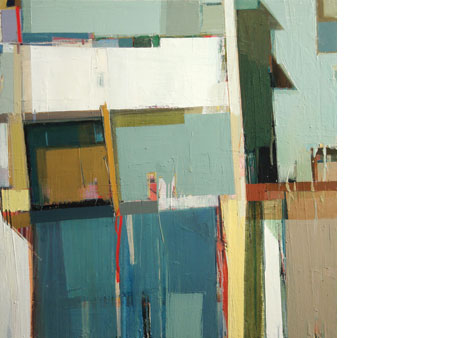
The neurologist Oliver Sacks recounted in “An Anthropologist on Mars,” the story of Franco Magnani, a San Francisco cook who, in 1965, began having vivid dreams of Pontito, the Tuscan village of his 1940s youth, and was thereby compelled, though untrained, to paint them, from memory, in astonishing detail; his visions became so powerful that, while painting, he re-experienced past sounds and smells and could even observe different vistas by simply looking around. Suhas Bhujbal’s masterful semi-abstract paintings of his childhood village, near Pune, India, may use photos rather than visions as sources, paradoxically eschewing photographic specificity, but they derive from the same urge to re-experience and preserve the past. Nostalgia is universal, and the San Francisco artist and teacher, who meditates, creates each painting as a “peaceful place” for us ungainly, hesitant adults, exiled from childhood’s magic circle of pure emotion and intense perception.
The show, titled “Reincarnation,” comprises sixteen oil paintings on canvas, nearly all titled A Quiet Town and numbered from 46 to 65, an obvious continuation (or willed artistic perseveration) of the A Quiet Town series begun three years ago. While Bhujbal’s watercolor cityscapes of India, not shown here, have a poetic, crepuscular stage-set look about them, his oils are influenced by painterly, intuitive, modernist abstraction. The broad color masses oscillating parallel to the picture plane derive from the tales (and pushmi-pullyu theories) of Hans Hofmann; the flattened, tipped space suggests sojourns into the non-monastic retreats of Diebenkorn and Thiebaud (whose giddy Nob Hill views might have been painted by hallucinating hermits perched atop Union Square columns); and the playful painterly conflation of walls and hanging laundry suggests both Cubist collage and Christo’s fabric-shrouded buildings/drawings. Nonetheless, Bhujbal’s “expressive cityscapes,” with their vigorously painted facades, courtyards, alleys, balconies, windows and cornices (elements of the ubiquitous, once-utopian concrete-slab architecture of the past century)—anonymous, stilled and muted, sans people, cars, signage or foliage—evoke a kind of universal nostalgia. They’re meditative landscapes that trap time and the tape-and-scrape creative process of distillation and intensification—not Wordsworthian emotion recollected in tranquility, but tranquility recollected through Bhujbal’s fervent, imaginative preservationism.
